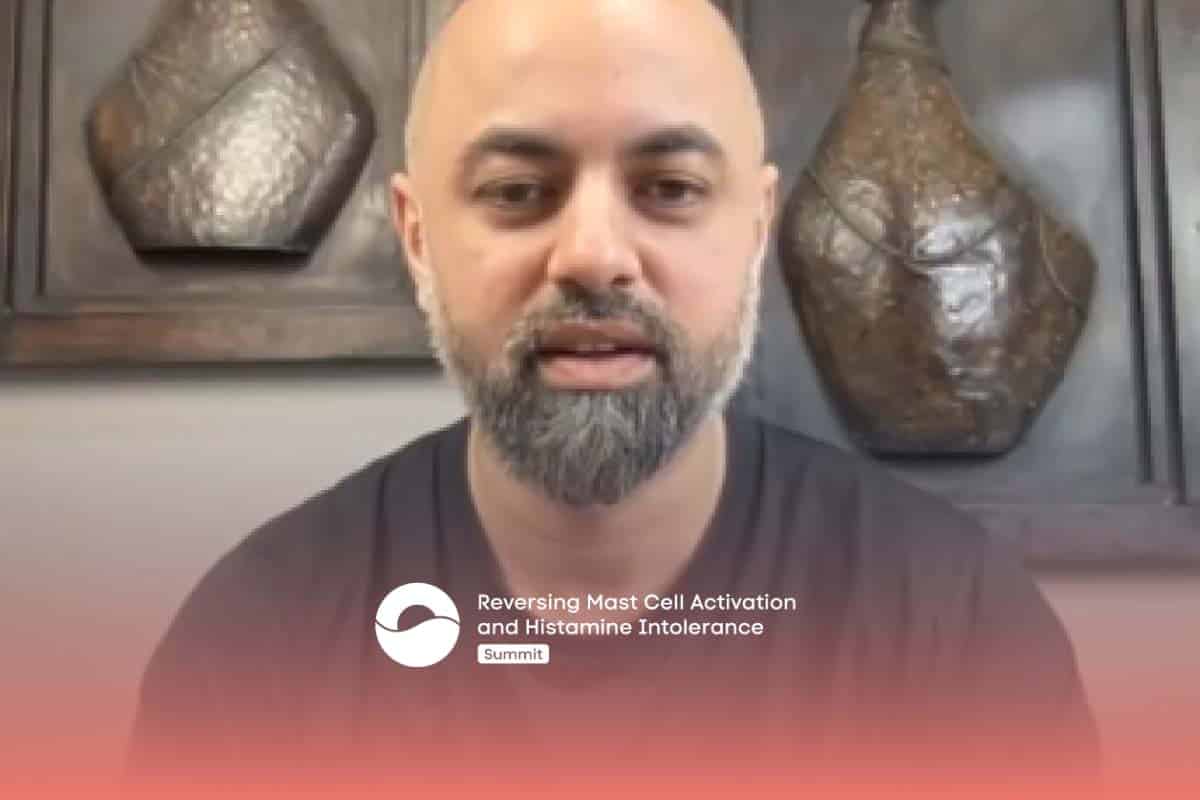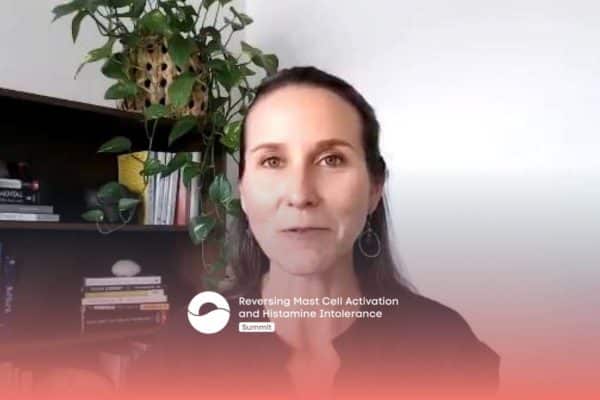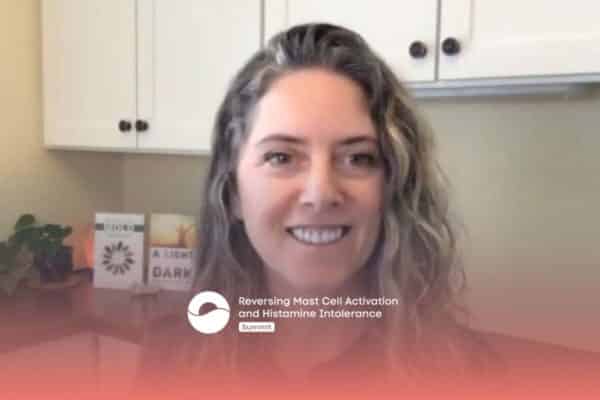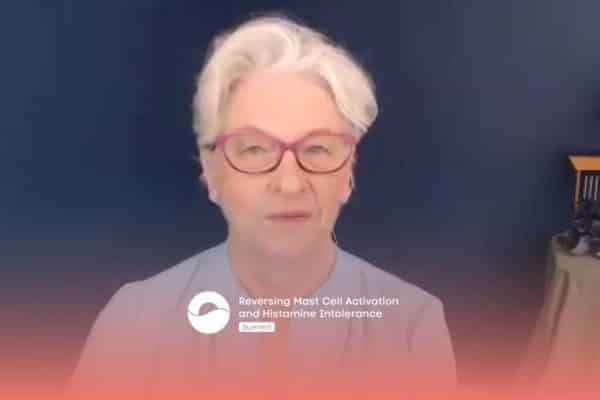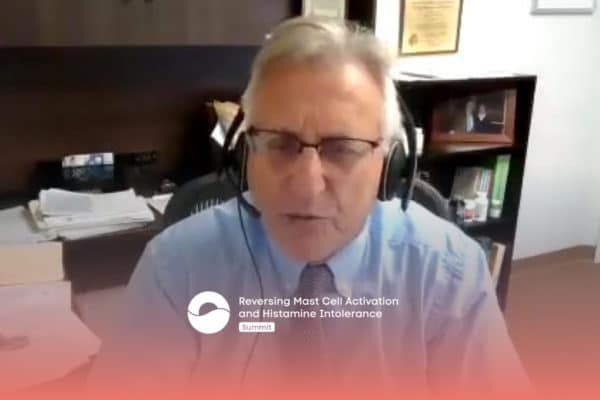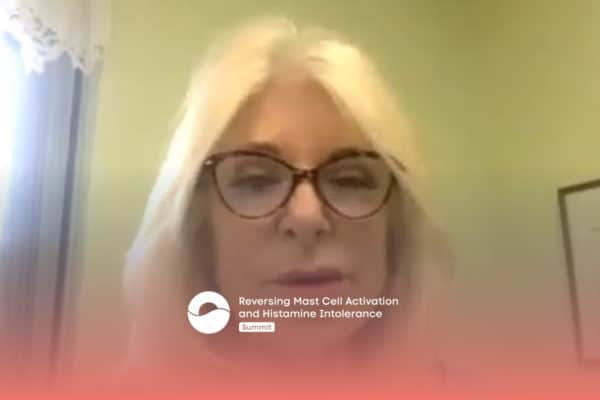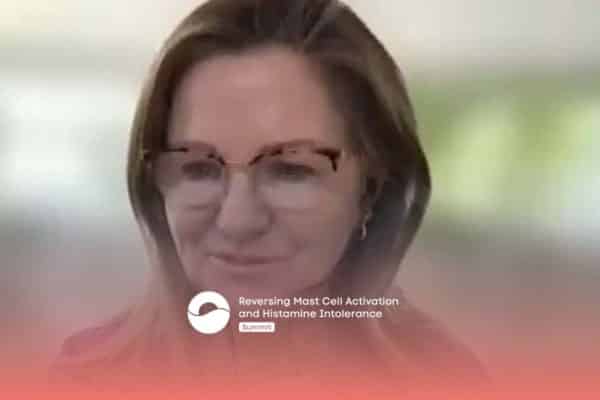Join the discussion below

Beth O’Hara is a Functional Naturopath, specializing in complex, chronic cases of Mast Cell Activation Syndrome, Histamine Intolerance, and Mold Toxicity. She is the founder and owner of Mast Cell 360, a Functional Naturopathy Practice designed to look at all factors surrounding health conditions – genetic, epigenetic, biochemical, physiological, environmental,... Read More

Kashif Khan is the Chief Executive Officer and Founder of The DNA Company, where personalized medicine is being pioneered through unique insights into the human genome. With the largest study of its kind globally, The DNA Company has developed a functional approach to genomic interpretation overlaying environment, nutrition, and lifestyle... Read More
- The most important factors in genetics
- Looking way beyond MTHFR
- Epigenetic factors in MCAS and Histamine Intolerance
Related Topics
Allergies, Alzheimers, Bedridden, Cellular Function, Copy Number Variation, Detox, Eczema, Environmental Factors, Epigenetics, Functional Medicine, Genetics, Glutathione, Histamine Intolerance, Inflammation, Lifestyle, Mast Cell Activation, Mcas, Methylation, Migraines, Mold Toxicity, Nutrition, Psoriasis, Root Cause, Tickborne InfectionsBeth O’Hara, FN
Welcome back to this episode of the Reversing Mast Cell Activation and Histamine Intolerance Summit. I’m your host, Beth O’Hara of Mast Cell 360, and I’m so excited to share this interview with you today that we’re going to have with Kashif Khan, who is the CEO and founder of The DNA Company. They focus on personalized medicine and really looking at this through these unique insights into our genetics. They are running the largest study of its kind globally developing a functional approach to genetic interpretation, looking at the overlay with environment, with nutrients, with lifestyle, to create these personalized health outcomes, which is so critical. We’re gonna dive into what this means. We’re gonna dive into why epigenetics and genetic expression are so much more important than just looking specifically at your genetic blueprint. Kashif has a ton of information to share with us. So welcome, thank you so much for joining us.
Kashif Khan
It’s awesome to be here, this is great.
Beth O’Hara, FN
Can you tell us more about how you got into the study of genetics and epigenetics? How did this come about?
Kashif Khan
Sure, so it wasn’t intentional, I can tell you that. I was pretty sick myself, and it was the tool that got me better. So I had eczema to the point where my eye couldn’t open, my left eye. I had psoriasis so bad that when I would clasp my hands, my knuckles would literally bleed, crazy migraines. My business partner would have to drive me home in the middle of the day. So everything was kind of falling apart all at the same time, and just like anyone else who first starts to experience these things, you treat them all with separate, siloed events. You know, there’s a doctor for this, a pill for this, a cream for this, and you’re treating them as all various labeled problems. I also had crazy allergies. They older I got, the worse they get, so I understand this immune response really well. All that is gone. I don’t have any of those problems now. So what was the key sort of turning point was nothing was working.
I was on all these pills, getting various tests and exams done, and it just kept getting worse. I felt like I was kind of managing all these cornucopia of various problems, versus understanding why they’re happening in the first place. So I met a functional medicine doctor who was a friend, and I asked him, “I heard you do things “that are a little more root cause. “What’s going on with me?” So he said, “It sounds like you have a genetic problem. “You have everything all at once.” I said, “What does that even mean?” So I looked into genetics, and I was honestly disappointed, because I took a couple tests, and I was told things like, hey, you’ve got an 80% chance of Alzheimer’s, a 60% chance. What does that tell you, other than anxiety for the next 20 years waiting to see? So that drove me to understand, why was genetics so underwhelming? And I found functional genomics, which was the same as the relationship between functional medicine and your primary care doctor. It’s the same thinking: how do I use genetics as a tool to understand why the disease is happening, as opposed to what the disease is, the true root cause. And the root cause typically, when it comes to things like diabetes, Alzheimer’s, things you’re not born with, these are not genetic conditions, typically require an environment/nutrition/lifestyle mismatch for the disease to express. I started to learn that, and I healed myself. Since then, I haven’t had a problem. It’s been a good five years now, right, where I spent most of my adult like sick. That literally took me to the point where I took the keys to my company, I ran a marketing company startups grow, gave it to my business partner, and said, “I found my legacy. “I have to work on this. “Everyone needs what I just got,” and never looked back. And that’s what we do.
Beth O’Hara, FN
I think so many people can relate to that, Kashif, because we have all these people in our audience that are struggling with these various symptoms. A lot of what you’ve described are actually symptoms that are related to mast cell activation, histamine issues. Then they’re going from specialist to specialist to specialist, and everybody’s giving them a one-size-fits-all approach. One of the questions I always have is, so one of the root causes we deal with a lot is mold toxicity and then those tickborne infections. Why do we have some people who are in a mold-toxic environment, in the same family, and one person is deathly ill or bedridden, and then other people in the household are not as sick? Why do some people get bitten by Lyme and other tickborne infections, those vectors in these ticks, some people develop symptoms, some people never develop symptoms, even though they’re carrying the bacteria, the pathogens? Part of that is our toxic load. Part of that is our genetics. But it’s exactly what you’re saying, that it’s this inter-combination. So you can have identical twins, one person in a pristine environment, not express those genes; one person being exposed to mold, heavy stress, lots of air pollution, and they’re gonna express those disorders? There’s plenty of studies behind all of that.
Kashif Khan
Yep, and you’re asking the exact question which should be asked which really answers everything. Take myself again as the guinea pig. Like I said, I had really bad migraines to the point where my business partner would drive me home. But why didn’t he have migraines? What was going on? So I found the source to be that in our office, the ground floor, there was a manufacturing company, and they were pumping toxins into our air vents that I was breathing in. Meanwhile, only I got sick; he didn’t. Why? Well, what I discovered later was when it comes to glutathione, glutathionization, the ability to bind toxins, send them to the liver to metabolize and get rid of them. People know that when you drink alcohol, it has an affect on your liver, because you’re cleaning things out, but they don’t think about everything else that you have to clean as you go through life. So there’s key genes there that direct those processes, and that’s what genes are. Just cut to the chase, it’s an instruction that tells your cells what to do. There’s certain genes for which we look for the SNPs or variants. People are familiar with those things.
It’s like the spelling mistake in the gene. You have that spelling mistake, it doesn’t do its job the same way as it should. What if you don’t even have the gene, literally, there’s an entire page of your instruction manual missing? That’s what happened to me. There’s a gene called GSTT1 which, it’s possible to have a different type of variation called a copy number variation. It’s not about what version of the gene did you get; you didn’t even get the gene. Some people have an extra copy of the gene. When it’s instructing something as important as the traffic cops in your bloodstream drawing on toxins to get rid of them, you could either be doing that at zero, or you could be doing it at 300%, if you have extra copies. My business partner, who has a very different ethnic background than me, he’s I think Scottish and Irish, he has an extra copy of this key gene. So when we were doing a renovation in our office, and they were doing epoxy to put this material on the wall for a lab, right, it’s like a smooth material, they were doing drywall, paint, I broke out in eczema. He walked around with no mask like it was no problem. So the key to how you take it from the genetics of, you have an 80% chance of a problem to, more certainty, getting away from that probability-based answer, you have to understand, if I’m telling you that you have an 80% chance of Alzheimer’s, I’m also telling you that 20% of people with the exact same genetic profile didn’t get it.
If your genes are that deterministic that they draw on cellular function and tell your cells what to do, so why do 20% not get it? They have the same instruction, same manual. It again comes down to environment, nutrition, and lifestyle, ’cause you weren’t born with the disease. You were born with greater risk, bad hardware, bad quality cellular structure that makes you more prone to that particular thing. But you still need to make the right or wrong choices to get your net result. This is the difference between, take my genetic profile, put me ancestrally where I came from, South Asia, and my family lived in the mountains, very clean, organic, they probably weren’t sick. Shift my context to what I wasn’t designed for, and all of a sudden, I’m a race car trying to drive off-road in the mud. It doesn’t work, right? That’s what happened to me, and I got so sick. So exactly to your point is that genes are what you’re wired to do, your capacity, your innate capacity. Your net result is now, what do you do with that tool that you’ve been given?
What are you designed for? Is that what you’re doing? Great, you’ll probably be healthy. Are you doing something very different? Then you will be that person who has mold exposure that ends up in bed because you are missing key genes, or that person that gets Lyme disease, and for some reason, is bedridden, when their friend didn’t even know they had it. The key processes of methylation and detox, et cetera, that create that additional load, you may be at this tipping point where you’re almost there because of something else, and you just needed the trigger of Lyme or mold or something else to push you over the edge, where you’re, again, bedridden. So this is where these differences come from.
Beth O’Hara, FN
I started looking at genetics about 10 years ago. It was one of the first things that validated that I wasn’t crazy. I was so sick. I had been bedridden. No one else around me was dealing with these issues. Everybody was in the same environment, and I’m the princess and the pea, where being behind a diesel type of vehicle in front of me, I’m getting ready to pass out. It was dangerous for me to drive at times, and no one else is this sensitive to anything. So I was labeled as crazy for quite some time, because nobody knew what I was dealing with. But then I could go, oh my gosh, well, look here, I have a ton of variants. I actually have that same missing gene. I am Irish heritage, but I have the same missing gene and a lot of other genetic variants, and a lot more than the vast majority of people. You talked about Alzheimer’s, and that we know those APOE genes, the e4e4 can increase that risk, but I also wanna put in there that most of these conditions, research shows us are really only around 20, 30% genetic.
Cancers, most cancers are only 20 to 30%. So we have this huge other percentage where we can change these with things like, you mentioned diet, you mentioned lifestyle, toxic exposure. Things like meditation change genetic expression. So let’s go now to talk about that genetic expression, because 10 years ago when I was looking at genes and getting all into this, and I was following ASCO and just these early people in the science of genetics, we were all going, well, if you have MTHFR, you should take methylfolate, you can’t process sulfate, and all these people were coming off of sulfur foods, but then six months later, they were worse, because you need sulfur to detox. We’re lightyears beyond that, but those simplistic equations are still all over the internet, and there’s a lot of education catch-up to happen. So can you help us with that please?
Kashif Khan
Yeah, so the challenge there was, and this is natural progression of any science, you have to start with what you have. The beginning was, what even is a gene? What does it even do? We had to discover that. Then we had to sequence the genome, which cost billions of dollars, which now costs a few hundred, right? So that had to be done. Then we had to understand, okay, I have this list of genes. What do they mean? What do I do with them? What are they actually doing? Does this make my eyes blue, or does it give me cancer? What is this gene, right? So in that research, in order for that to be done effectively and quickly, there was this very gene-siloed approach. What does this gene mean? What does this gene mean? What does this gene mean? But the body doesn’t work that way. The body isn’t 22,000 independent genes doing independent processes, which is how many genes you have, 22,000. They’re systems, which we already know. We already know there’s a hormone system and a cardiovascular system and neural networks that are driving neurochemicals, and we already know what all those things are. So what needed to be done was first of all, we needed to do this gene by gene to understand what genes are important, what matters. We then needed to go back to what we already knew, which was human biochemistry. Here’s what we already know is going on. Now let’s take these genes and plug them in the processes that already exist. If this gene instructs something in methylation, like MTHFR, like you talked about, that’s great.
We know that now. But that’s one step out of seven or eight steps. And now all of a sudden, there’s a lot more precision to methylfolate or what version of B12 or sublingual, or adenosyl- or methyl-cobalamin. Like, what are all these choices you have? When you look at the full cascade, here’s what methylation actually looks like as a process in biochemistry, and here’s the genes that instruct, as opposed to, what does this gene mean, what does this gene mean, what does this gene mean, which is the way geneticists think, because that’s how they research, all of a sudden, you can take this, again, probability-based stuff and make it very certain. Methylation as a process versus a bunch of independent genes, you have two very different outcomes if you look at it like this. Look at it in the context of the human body, the way the body actually works. Lemme give you an example. So I don’t know if I mentioned, but one of the problems I had when I was sick was depression, right? There was days where I just didn’t wanna go to work, and it started in my 30s, never happened before that. So there’s a neurochemical called dopamine, and what dopamine is what allows you to feel pleasure, but also reward.
Eat some tasty pizza or do something, go to work. It’s both of those feelings. When you look at things genetically, there’s a gene called DRD2, and you’ll see it’s talking about things like addiction. You are more prone to addiction because of the variant of this gene you have. Then a lot of people say, “Well, I have this version “of the gene, but I’ve never been addicted to anything. “You’re wrong. “Genetics doesn’t work.” So what you have to look at is the cascade. How does that neurochemical actually process, and what environments would cause various problems? Now, truth is, it’s addiction, it’s also achievement, and it’s also depression. It does all three things. You have to first understand the full pathway, which I’m gonna describe, and then the context that you’re in. So the full pathway is, the first step is, you need to experience dopamine. You need to bind and connect to experience that pleasure or reward. Then MAO, that other gene, breaks the dopamine down, to get you back to normal.
Beth O’Hara, FN
Which also breaks down histamine.
Kashif Khan
Exactly, yeah.
Beth O’Hara, FN
Just another -amine, just to throw that in there.
Kashif Khan
This is the other challenge, is people think about genes as single-purpose or single-factoid, and they’re not. There’s so many multi-purposing and multisystems and systems interlinking, right? So you have to understand, again, how does the body work. Then there’s an enzyme called COMT, which is driven by the gene COMT, which now sweeps up that broken metabolite, gets you back to normal. It also deals with hormones.
Beth O’Hara, FN
And phenols like quercetin, salicylates.
Kashif Khan
Exactly, so you can’t just look at it as one, “this gene is related to addiction.” No, this gene clears broken metabolites out. Now you have it discover all the metabolites it deals with. So now I have the lowest version of the DRD2 gene, which means my receptors are sparse. I don’t really feel. I had the fastest MAO and the fastest COMT. So I feel it way down here, and it lasts that long. So for me, yeah, addiction is a really powerful option, because when I do finally find that thing that I enjoy, I’ll get hooked on it, and when I was young, as a teenager, we grew up in poverty, and when I finally found something enjoyable, I got hooked. So my context of being unhappy and not getting pleasure because we couldn’t afford pleasure, really, compared to the people that I saw around me, and then finally experiencing it lead me to addiction. So that was one potential route. Then when I was in my late teens, my father passed away, and I became responsible for the family. I had to work. So I started working and working and working, and a few years went by, and all of a sudden, I had a team of employees, and I owned a couple businesses.
I didn’t even understand how that happened, because the same neurochemical pathway drove me towards reward. That feeling of achievement felt so good that I kept chasing it and chasing it and taking bigger risks and bigger risks. Context changed, so the meaning of the genes changed. Then I get into my 30s, I built a pretty decent business, and I felt like I was doing okay. I had my first kid, and things were kind of slowing down. I became depressed ’cause I stopped trying. I didn’t have a reason to push or pursue it. I wasn’t taking those risks and getting those dopamine hits every day, and so I didn’t wanna get out of bed and go to work anymore. So it’s not single gene, single meaning, single factoid. It’s, how does the body work, and now, how does each gene instruct each step? And guess what, this gene doesn’t only do that. It does other things too. And this system doesn’t only do that. These systems are interconnected, and the context will shift your outcome, I had three different contexts in three different parts of my life, and the same gene pathway led me to three different paths. Now if you layer on top of that nutrition, what was I eating, environment, how did I exercise, the genetic expression, there’s even more nuances pushing me further down or away from a certain path. And that brings you to really precision, you know exactly what to do about what’s going on.
Beth O’Hara, FN
That’s so great. I love this example, and then if we layer the nutrition piece, we know that there’s a gene called DBH that produces the DBH enzyme that helps convert dopamine to epinephrine, norepinephrine. That’s dependent on vitamin C, and it’s inhibited by Clostridia bacteria, so Clostridia overgrowth in the gut. So we can have all of these aspects going on in our lives that are gonna shift, and that’s what’s so different about the type of gene reporting we can get these days compared to when I started. And I’m not dissing these tools at all. They were great tools 10 years ago.
Kashif Khan
You needed to start there.
Beth O’Hara, FN
They saved my life, because I was able to start going, oh my gosh, glutamate, now I understand why I’m so sensitive to glutamate foods, and I could start putting some pieces together. But we’ve evolved quite a bit, where you can start to interlace these various genetic pathways, the nutrient side, the lifestyle side, who’s gonna be more sensitive to stress? Who’s gonna be more sensitive to nutrient depletion, and things like that.
Kashif Khan
Yeah, and the key to what you’re saying is we now have better interpretation, meaning most genetic companies know how to run a test and to tell you what version of what gene you have. How much is that gonna change your life? That starts with interpretation. What does it mean? How does this apply practically? So that learning came from clinical practice, like functional medicine doctors, integrative doctors, executive clinics actually using genomics to say, “Wait a second, this report’s wrong, “’cause when I do this, this happens, “and when I do this, this happens.” So we did the same thing. That study that you talked about, the largest study of its kind in the world, we realized that the reason why genetics was broken is because genetic research was only researching genes, not people. It wasn’t applied in the context of how people actually do stuff. So we shifted gears.
We said, let’s actually be patient-facing. So we met 7,000 people one by one by one by one and understood their physical traits, how they behaved. We were able to document their behaviors, document their hair, their skin, everything about them to understand, what do the genes actually net out and equal, and then of the various choices that people make, why did some people get sick and some didn’t? And some of them are counterintuitive. Some of them are obvious. It’s what your doctor would tell you anyway. Some of them were the exact opposite of what your doctor would tell you. There’s certain people where you have to tell them, you should not be doing cardiovascular exercise. We understand you’re trying to make your heart healthy. Guess what, you’re slowly killing your heart. And this applies in this sort of mast cell and histamine world because one of the things that happens is mass inflammation, and it’s been studied that the inflammatory load from this histamine response, one of the areas where people feel it is the endothelial. It affects the endothelial aggressively, and you may not realize that.
Beth O’Hara, FN
Explain what that is for our listeners.
Kashif Khan
Oh, sorry. So most heart disease doesn’t happen in the heart. It typically happens in the arteries around the heart, so blockage, calcification, cholesterol issues. Most of that isn’t based on the thing that you’re treating, the cholesterol problem or whatever. The inner lining of the artery is endothelial. It’s that inner cellular structure that the blood actually touches and flows through. That’s the endothelial. People have different quality versions of this hardware. Some have a resilient stainless steel where you can see your old grandma smoking a pipe ’til she’s 100 years old, and you can’t figure out why. That’s probably her. Then there’s some people, much more, by the way, it’s less likely for you to have the good quality version of the hardware, have not so good cellular structure here, so it’s more prone to inflammation. That endothelial runs throughout your body and your vasculature, everywhere throughout your body.
So if you have the not-so-good version, which means it’s more prone to inflammation, and you are suffering from something like histamine issues, mast cell issues, which you know you’re already having an inflammatory load, this is one of the areas where you’re gonna have a net effect, which you may not know, ’cause there’s nothing sensorial about it. There’s no pain, until you go to the doctor one day, and they tell you your cholesterol numbers are up. And you say, why? I eat perfectly. I run on the treadmill every day. Well, that’s maybe the problem, because you may not have the ability to clear, the same person who’s gonna suffer from histamine response, mast cell, mold issues, Lyme issues, have the adverse reaction, is the same person that can’t clear the oxidants caused by cardiovascular activity. You’re taking in oxygen, breathing super heavy, so you’re taking in way more oxygen to create more oxidants. Your cells take in oxygen and nutrition to create energy. That’s what they do. But in that process, they create oxidants, which are highly toxic.
Beth O’Hara, FN
Sorry, so sorry, lemme just bridge for a second where we’re going with cholesterol for people who this is big news for, that cholesterol we know now is not related to diet, people eating dietary cholesterol. Speaking of cholesterol in the body, when cholesterol goes up, it’s an inflammatory marker. It’s a marker that detoxification pathways like sulfation aren’t working well to convert things like bile and our steroidal hormones. So that’s where this goes. I just wanna make that link for people.
Kashif Khan
Exactly, yeah, and that’s exactly what we’re trying to teach people now, is that that outcome of, I had a cholesterol issue, could be rooted in your detox issue, because you’re causing the inflammation here for which your body’s response is to use cholesterol as a hormone to reduce the inflammation. And if you have the not-so-good version, 9p21 is what we look at to determine this. If you have the not-so-good version, you’re just gonna get there a lot faster, and then that cholesterol buildup is gonna happen a lot faster. And guess what, when cholesterol meets toxicity, it actually hardens and gets deposited. It can’t move. If you have the bad version of the APOE gene, which you talked about earlier, cholesterol transport, it’s even more exaggerated. So this functional approach of looking at all these various components to really understand where you’re at. So that’s one sort of outlying problem that takes years to develop. The nature of chronic conditions, you don’t turn a switch and get them. They take many years, decades sometimes to develop. But if you don’t deal with your histamine issue and mast cell issue, mold issue, Lyme issue, one of the outcomes potentially could be cardiovascular health issues, ’cause you’re causing the inflammatory load, which leads to the cholesterol issues, which leads to, and so on and so on and so on, right? So this is why everything is so interlinked. You need to understand the systems, not just the genes.
Beth O’Hara, FN
Yeah, that’s perfect. And it’s not that you’re saying don’t move, don’t get any kind of exercise, but you can tailor the kind of exercise. I’ve always been that over-achieving, had to constantly be on the go, and if something’s good for me, 150%’s gonna be better. So all of my life, I pushed and pushed and pushed myself to try to be a runner. You know, I wanted to be able to train for marathons. At one point, I was doing long-distance bicycling and building up for 50-mile bike rides, and no matter how I did it, I crashed so hard, every approach I made. And it finally came to me that my body’s not designed for that. Now, I do plenty of exercise, but for me now, it’s like, two and a half mile an hour on the treadmill, a good pace, get my blood pumping, but I’m probably not ever gonna be a marathon runner. In my 40s, you know, I’m getting a little later for that, right? But it was inflammatory. I noticed my fatigue would get worse and worse, and then I couldn’t get out of bed. My hands were swollen, my joints hurt. Something is going on in those pathways that are telling me that this is not good for me, even though everybody says, oh, you’ve gotta get all this intense exercise. Even high intensity like the interval training doesn’t work for me. I crash out, and it’s something about that.
Kashif Khan
Yeah, and you’re designed for more weight training, resistance, push heavy things, right?
Beth O’Hara, FN
I did great with that.
Kashif Khan
And most people are. So this is where I was in the exact same boat as you. It sounds like we’re genetic twins. We’re fairly similar in our makeup. And I firmly believe that if I had done things right, I wouldn’t have all this white hair. I’ve aged myself prematurely because I thought I was doing everything right, ’cause it’s what everyone else was doing. But it was not designed for me. Literally, that oxidation, that load, it was not designed for me, and that caused me to age prematurely. I’m certain of that.
Beth O’Hara, FN
I’m hiding my white hairs still. So we’re looking at now not as much specific mast cell genes, but the whole picture, the inflammatory picture, because we know that inflammation of the body, there are over 200 receptors on the mast cells. So any of form of inflammation in the body is gonna dock on one of those receptors and start triggering those mast cells. So we’ve gotta lower that overall inflammatory load, and even with histamine, again, we’re looking at this whole pathway, not just the DAO gene or just the MAO gene, but we can look at histamine production, we can look at multiple histamine degradation pathways, which most people don’t even know that there’s the pathway that clears alcohol is down the road from DAO and clears histamine as well. So that’s your second step after DAO. Is there anything else you wanna add around that mast cell/histamine side?
Kashif Khan
Yeah, so the way we think of things functionally, so there are very specific genes that are studied around both. We don’t look at them. What we look at is, why do some people get a little sick, some people get medium sick, some people are in bed? That’s what we try to help with, that disparity between the various outcomes. And that isn’t resolved by resolving the mast cell or histamine problem, although of course, if you impact it, you’re impacting it. There’s exponential sort of headache or pain when there’s multiple things going on in the body. For someone that is perfectly healthy, has zero inflammation, no problem, they have this issue, they might not even know, just like Lyme disease. They get hit by the bacteria, they don’t even know. Then somebody who’s already on the tipping point of, there’s mold in their basement, they don’t clear toxins so well, they work in a factory with chemicals, they just needed something to push them over the edge. They were almost there. So this is where we look at things functionally, to look at the key systems of glutathionization. It’s not just one gene; it’s a whole system where, just like I said of GSTT, GSTM, same thing. You can be missing it. Forget about what version; you don’t even have it. Then this secondary gene, not there, GSTP, so important in clearing.
You could have a very specific version, which means you just don’t do that process so well. Then you go to a naturopath and they give you glutathione, and you don’t have the genetic instruction to tell glutathione what to do, and it just makes you feel worse, ’cause it starts binding onto minerals and nutrients also, not just the toxins, ’cause it’s not being instructed properly. So doing that well and bringing your sort of toxic load, any autoimmune-type issue often is rooted in environmental toxins, not only, but that’s usually a big part of it. It’s usually one of the parts that we don’t recognize, ’cause it’s not obvious; it’s not in your face. Some things you don’t even realize are toxins that are in your water and your food and whatever, you don’t even notice. So either reducing the load, which is tough. It’s very challenging. You live in your house, you eat your food, you’re gonna go to work; it’s very hard to reduce the load. So often, the more important thing is to increase capacity, ’cause really, those are your two choices. You gotta turn one dial or the other. Increase capacity means knowing exactly where you’re not doing well and then supplementing, supplementing with the right stuff, not just, here’s my detox pill from CVS. You gotta supplement where you’re not doing well. That is true of detox. It’s true of methylation also, and you have to be very specific on how you supplement in methylation.
Again, we talk about the entire cascade as opposed to just a gene, MTHFR. And I can’t tell you how many people will be told from a genetic consultant that MTHFR’s great. You’re great with methylation. Meanwhile, everything else, all the supporting characters are failing. So this one reaction within this entire process is great, but everything else sucks, so you can’t be doing well. So you have to look at the cascade. And again, there’s very specific supplementation. Your two options, again, reduce the load, increase capacity. Those are really your two options. Then the third area, which typically doesn’t get spoke of but is so important functionally, is mood and behavior, your perception, ’cause it applies to compliance. Like, am I even gonna do the stuff I’m being told? It applies to the reward-seeking behavior. You, if somebody tells you specifically, you’re gonna do it. You’re wired for it. Just like you said, the 150% of the right number for you. But there’s some people where 50% is too much, and we can understand that genetically based on their reward pathways, based on their serotonin pathways and how they deal with irritability and stimuli and all this type of stuff. So understanding your neurochemical makeup allows you to personalize how you take this information in.
How do you perceive it? When you say it’s seven out of 10, is it really seven out of 10? Is it two, or maybe it’s 10, but based on the way you think, you’re not actually close to what’s actually going on? Your ability to deal with your clinician or your coach or the person that’s actually guiding you through this process. How do you take in what they say? How do you perceive what they’re saying? Is it a personal insult every time, or is it dry instruction? How do you actually perceive things? That’s all genetically wired. So that’s one of the biggest areas where, at least when we are personally working with patients and coaching them or building them programs, a big part of what we consider before we even get into the therapeutic recommendations is, how do they think? And to know this about yourself, the people around you who you have to ask to change to support whatever changes you need, when you go to Christmas dinner, when you go to work, it’s a different environment, and you can’t control it anymore.
So how do you even talk to those people about what you’re doing? All of that starts with this. So that’s what we always recommend to people: understand your neural wiring, who you really are. Then get into, where am I weak genetically? Then understand, am I gonna choose to stop the toxic insult, turn down that dial, or can I not control that, and I’m gonna start to supplement or change food, diet, et cetera, to increase capacity? That’s kind of, excuse me, the process we go through with people, and all of a sudden, the approach is more functional. We haven’t even touched mast cell or histamine yet. We’re saying, let’s just get your body ready to deal with whatever your clinician is recommending for that problem. Now the outcome of the work that you do or somebody else does with them, they’re gonna get so much further down that healing journey, because they’re removing the load, all this other stuff like comorbidities that are tied to this that make it so much worse. That’s what we see our role as in this whole puzzle.
Beth O’Hara, FN
Gosh, I love that, and that really ties into our philosophy, and that’s why we called it Mast Cell 360, ’cause we wanna look at the mindset, the psychology, the social relationships, and you’re talking about how people take in information, bring in the personality piece, so there’s that coaching element to what you’re doing. There were a couple pearls in there I wanted to go back to for a minute, really great ones. One was that, we keep touching on this methylation pathway, and for people who don’t realize, it’s much bigger than MTHFR, that there are multiple genes in that pathway doing different things. We have all these nutrient cofactors beyond methyl B12 and methylfolate. We’ve got potassium and zinc and magnesium and these other things. And the blockage may not be at methylfolate. So just because somebody has elevated homocysteine doesn’t mean it’s a B12 or a folate issue. That’s why pulling all the info together is helpful. But then you were talking about the GSTs, and I wanted to come back to that. So GSTs help glutathione target a toxin and attach onto the toxin. What do you recommend? This is something I’ve actually been on the hunt for, because you were talking about, if you start taking glutathione, because the instructions aren’t there correctly, then it might start targeting minerals or other things you don’t want it to target. So let’s just go to that little nugget. What do you recommend on those GSTs?
Kashif Khan
So what we’ve sort of done in practice is things like NAC. It’s the precursors, things that don’t need instruction. They just go straight to work. So NAC, selenium, alpha-lipoic acid, basic stuff, milk thistle. Sometimes there’s certain combinations of these things that we give people. We’ve also used third-party product that we’ve tested. You know, we’ve been the guinea pigs, and in general, yeah, one challenge, however, is NAC, they’re trying to make sure that you can’t buy it anymore, which is becoming difficult. I understand that in certain contexts, it can be considered prescriptive, but that’s been a very powerful tool. It’s been helping a lot of people. Some people also don’t do well on it, but for the most part, that’s what we’ve been using, and it’s been very helpful. Then we have some really sort of interesting cocktails that we’ve been experimenting with. We actually built a compounding pharmacy in the middle of our office. So we have techs that literally compound nutraceutical pills that we test with people. There’s some things that, again, support a system over here, and another system thrives over here ’cause of that load. There’s unique ingredients like tocotrienol, which is vitamin E, which has been proven to do really well with brain health, endothelial health. But again, it reduces inflammation in certain areas, which allows other stuff to work better. So we’re not targeting that problem, but by supporting everything, you get into this sort of homeostasis where everything is working right. So it’s also about understanding other inflammatory targets and getting rid of those. So yeah, that’s some of the stuff we’ve been up to.
Beth O’Hara, FN
Yeah, that’s great. We know that high gamma E, that form of gamma E is helpful for mast cell activation from the inflammation reduction as well. So this has been amazing info. One of the things that people always ask about is privacy with DNA testing, and particularly, there’ve been a lot of issues with that, a lot of very valid concerns with that. Can you talk about this some more?
Kashif Khan
Yeah, so it’s kind of a dirty secret of the genetic industry that the genetic business isn’t a very good business, because your DNA doesn’t change. So I test you once, and we’re done, right? So that challenge of this promise of new discovery, new science, et cetera, entrepreneurially was failing, so the investors for all these various companies were saying, “Well, you gotta figure something out here.” So what did they figure out? Well, we have a human sample. We have your DNA. That must be worth something to somebody. So the genetic testing industry became a data-selling business. And this is partly why the consumer reports are so disappointing, ’cause they’re not designed for you. They’re designed for the buyer of the data. The person who’s paying 200 or 300 dollars for a test versus the buyer of the data who’s paying $5,000 per dataset. So you can be assured that whatever you’re buying was designed for them. What genes do they need to know more about, in what order, et cetera. And so, that led to this sort of underwhelming reporting, which is more recreational or infotainment type stuff.
Beth O’Hara, FN
We saw that really in 2017. I’ve done a lot of genetic testing, and the data quality that we were getting from the major company that was out there, they switched versions, because they were bought by a pharmaceutical company, and I lost about 60% of the data that I was looking at, just in that version change.
Kashif Khan
That was the exact time when this all happened. So 2017 and 2018 was when Glaxo came in and funded 23andme $300 million, shifted the purpose of why they were there, and that happened with several other testing companies in that exact time, 2017 to 2018. So that’s when the entire business became a data collection business to help design personalized medication. So what we said is, in this problem, there’s a major opportunity, ’cause people still want good information. They still want somebody to take their genome, mine it for data, and tell them everything. So we did that. We said, let’s be the insight company. We’re not the data-selling company. We believe that if we overwhelm you instead of underwhelm you with powerful information, you’re gonna stick with us, and you’re gonna say, “Can I work with you in coaching? “Can I buy some supplements? “Can I buy the next report that’s coming out next month?” So that’s what we did. And we were only able to do that because of, again, the study of those 7,000 people to document things that are actually actionable that we could teach. So that’s a very important consideration, and I would say for the most part, if you’re giving up your data, you’re giving up your privacy. You have to sign things that are consent to research. We make it purposeful that we don’t do that. That’s not our business. Our business is to teach you so much that you’re gonna wanna stick with us.
Beth O’Hara, FN
So you don’t sell any data?
Kashif Khan
No. In fact, our system is all anonymized and aggregated, so if somebody went and hacked it, it doesn’t even point to anybody.
Beth O’Hara, FN
So that’s helpful to know, because people also have concerns that if someday, their genetic data gets to insurance companies, that they’re gonna lose their benefits. So that’s huge, that it’s all anonymous. This has been an incredible interview, amazing information. It’s so helpful, and I wanna thank you, both for joining us out of your busy schedule and also recovering from your cold, and also, thank you for your support of the summit. Your company is one of our supporters that helped make this summit possible. Can you tell people where to find you if they want to get involved with your reporting and your genetic kits? How can they find that, and we’re also gonna have all this on our resources page, and that’s at mastcell360.com/summit.
Kashif Khan
Sure, so it’s thednacompany.com, thednacompany.com, and the test we’ve been talking about is called the 360. So we call that ’cause it’s sort of all-encompassing, which, it goes through six key systems that we think everybody needs to know about, which is cardiovascular; diet/nutrition; hormones and fitness and body type and body development, that type of thing; immunity, so cellular health, which is so important in what we discussed today; mood and behavior, everything about the brain, which is actually the biggest report; and then sleep, because sleep drives all this other stuff. If you’re not sleeping right, you’re probably not doing well. So why is it that I can’t fall asleep, can’t stay asleep, sleep through the night but wake up feeling like garbage? Genetically, those are three different things. So these six things come in the 360 report. That’s sort of the flagship product you’ll see on the website. From there, if you choose, if there’s a particular problem you wanna work on, if there’s something, I need to lose 10 pounds, whatever the thing is, we do have coaches that are trained genetically to help you do that.
So you’ll see when you get to the website, the 360 is the test. Then there’s various levels of coaching for different people that have different goals. Some people say just, “I wanna rip myself apart “and build myself back together genetically,” right? That’s a whole other layer. There’s some people that say that my mom had breast cancer. I just wanna make sure I’m safe. So there’s various levels of coaching we can do. And our intention is that because the same algorithm or artificial intelligence that we build to populate the reports also ties to solutions, meaning that if we know, here’s what’s wrong, we also know uniquely how to fix that. So we’re gonna keep curating things like supplements, like therapies, like people like yourself who are specialists and experts, to tie to that person’s genetic weakness so they know what to do about it. That’s really the long game for us, to say that once you’re in this ecosystem, you’re gonna find the things you need driven genetically. So they’re solving your specific, particular problem at the root cause, as opposed to masking the symptom.
Beth O’Hara, FN
That’s great. Thank you so much again for joining us and sharing your wisdom, your experience, your knowledge to help people in our audience get their health back.
Kashif Khan
It’s a pleasure. It was awesome joining you.
Downloads

